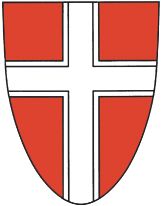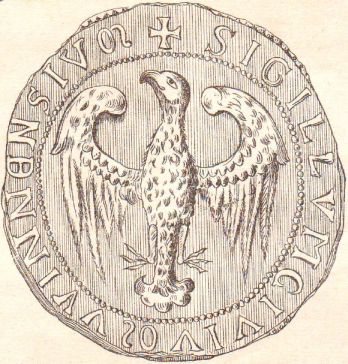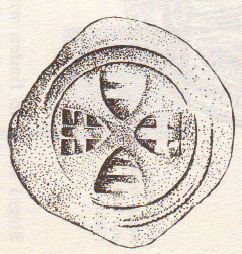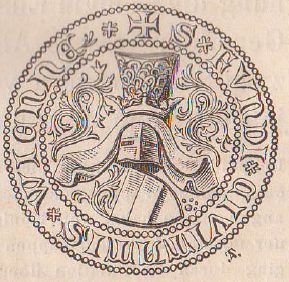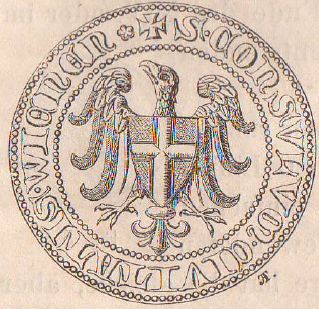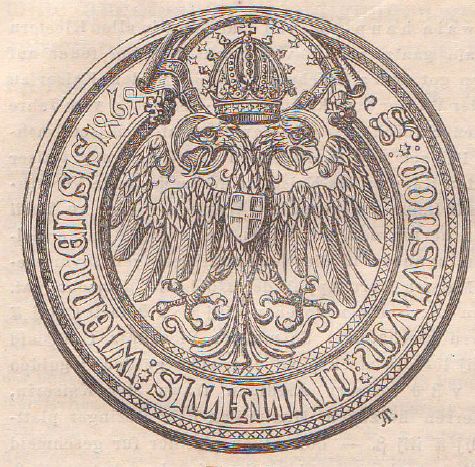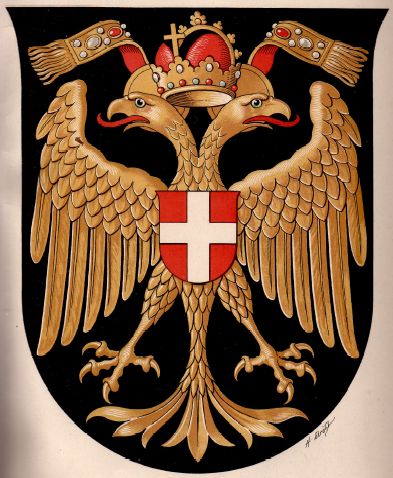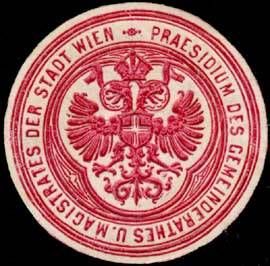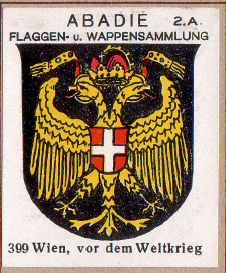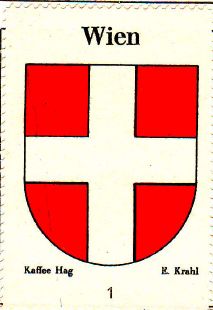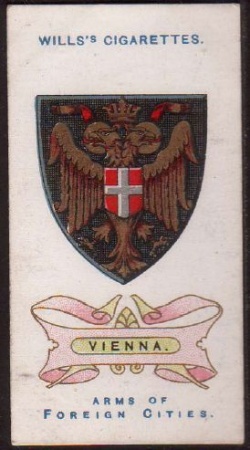Wien
WIEN (Vienna)
State : Wien
Official blazon
Origin/meaning
The history of the arms of Wien is long and complicated. The oldest seals of the city show only an eagle. The eagle is most likely derived from the arms of the Dukes of Austria of the Babenberg dynasty. The oldest seal of the city hangs on a document from 1228, but the only remaining document is a copy of unknown date. It its thus not sure whether the city already in 1228 actually used this seal. The oldest original seal hangs on a document from 1239. Another hangs on a document from 1281. The city used smaller (contra- and secret-) seals with the eagle well into the 16th century.
| The oldest seal of Wien (image from Grenser, 1866). |
At the end of the 13th century the city also used already the arms with a cross, but not on its seals. A coin issued in 1278 shows 4 shields with the cross. The cross itself is probably a reference to the crusades, to which the people of Wien also participated. It may also simply be a symbol of religion in general. The colour of the cross, silver in red, is known from a book from 1395 and has not changed since.
| A coin from 1278 (image from Martinek,1964 ).. |
The Dukes of Babenberg joined the crusades and fought on the battle of Acco in 1191. According to legend, Duke Leopold was the first to scale the walls of the city, with his white tunic completely covered in blood, except for under his belt. The silver bend on red thus became the arms of Austria. The city used seals with the Austrian arms from 1360 until the 17th century, but only to seal documents dealing with the transfer of land. This probably indicated that the land was a possession of the Dukes of Austria and the city acted as its representative.
| The seal used for land transactions (image from Lind, 1866). |
The first combination of the arms with the cross and the eagle appeared on a seal from 1327. This seal was used during the whole 14th century in different variants, see examples below.
| The seal of Wien from 1346 (image from Lind, 1866). |
The seal of Wien from 1399 (image from Lind, 1866). |
On September 26, 1461 Emperor Friedrich IV granted the city the use of the imperial double headed eagle and Imperial crown. The shield with the cross was not mentioned. The eagle was, for political reasons, not described as the Imperial eagle, but as just a double-headed eagle. As in 1463 the city was lost for the Emperor during the war of succession in Austria, the Emperor retracted all privileges to the city, including the arms granted two years earlier. All rights of the city were transferred to the city of Krems-Stein, which still uses the arms.
| The arms as shown on the privilege of 1461. (image from Lind, 1866). |
After the privileges were lost, the city made peace again with the emperor in 1465 and showed on its seal the double eagle with the cross on its breast. Whether these arms were officially granted, or simply assumed by the city is not known.
| The seal of 1465. (image from Lind, 1866). |
The arms with the eagle and cross in a single shield have been used until 1925. The shape of the eagle, the presence of the crown and other smaller details have differed widely during the centuries, but the basic composition remained the same. In many cases the cross appeared without the eagle as arms of the city as well, but on the official seals the eagle was always present.
| The arms of Wien during the Austro-Hungarian Empire, as shown by Ströhl in 1902. |
After the end of the Empire in 1918 the country abolished the double-headed eagle as the symbol of the Emperors, but the city did not immediately follow. In 1925 the city council debated on the use of the old arms and finally in February the council decided that the official arms of the city of Wien were a silver cross in red. In an additional decision it was stated that the arms could be placed on a single-headed eagle. In 1934, the new commisionner of the city of Wien issued a new law, stating two official arms for the city; the small arms with only the cross, and the large arms, which showed again the double eagle, with crown, similar to the arms before 1925. In 1938 the small arms were abolished and now only the arms with the double-eagle were official. In 1945 the city again returned to the arms of 1925, and the arms were now again officially only the cross, but a single-headed eagle can be used as supporter. At present the supporter is not or very rarely used.
| Seal from around 1900 |
The arms in the Abadie albums |
The arms in the Coffee Hag album +/- 1932 |
| The arms on a cinderella stamp |
The arms on an English cigarette card |
Wiener Bezirke
The city of Vienna is divided into 23 districts or "Bezirke", usually referred to by Roman numerals (Wien I through Wien XXIII) and/or their respective official names, such as "VIII. Josefstadt" The names of the districts derive from formerly independent suburban villages or from former parishes. Each of today's districts is composed of several independent villages or parishes, so with the exception of Wien I and XXIII, all arms are compound arms.
| Composite arms of all villages and parishes in Wien (Ströhl, 1902) |
The arms of the Districts (Bezirke) of Wien :
Wien I
The arms of Wien I : Innere Stadt are identical of those of the city as a whole, as until the mid 19th century the jurisdiction of the city was no more than the present district I.
Wien II
The arms of Wien II, Leopoldstadt, shows three parts symbolising the formerly three independent communities Wien-Leopoldstadt, Wien-Jägerzeile and Wien-Zwischenbrücken.
Wien III
The arms of Wien III, Landstrasse are divided into three fields showing St Nicholas, a strawberry and two bucks, representing the former communities Wien-Landstrasse, Wien-Erdberg and Wien-Weissgärber.
Wien IV
The arms of the Wien IV, Wieden, in their present shape were created during the late 19th century and combine the arms of the three communities Wien-Wieden, Wien-Schaumburgergrund and Wien-Hungelbrunn.
Wien V
The arms of the Wien V, Margareten, combine the arms of the six communities Wien-Margareten, Wien-Nikolsdorf, Wien-Matzleinsdorf, Wien-Hundsturm, Wien-Laurenzigrund and Wien-Reinprechtsdorf.
Wien VI
The arms of the Wien VI, Mariahilf, combine the arms of the five communities Wien-Laimgrube, Wien-Windmühle, Wien-Magdalenengrund, Wien-Gumpendorf and Wien-Mariahilf.
Wien VII
The arms of the Wien VII, Neubau, combine the arms of the five communities Wien-Neubau, Wien-Altlerchenfeld, Wien-St. Ulrich, Wien-Schottenfeld and Wien-Spittelberg.
Wien VIII
The arms of the Wien VIII, Josefstadt, combine the arms of the five communities Wien-Josefstadt, Wien-Altlerchenfeld, Wien-Alservorstadt, Wien-Breitenfeld and Wien-Strozzigrund.
Wien IX
The arms of the Wien IX, Alsergrund, combine the arms of the seven communities Wien-Alservorstadt, Wien-Althangrund, Wien-Himmelpfortgrund, Wien-Lichtental, Wien-Michelbeuern, Wien-Rossau and Wien-Thury.
Wien X
The arms of the Wien X, Favoriten, combines the arms of Wien-Favoriten with symols of other parishes. Oberlaa is symbolised by the water fountain that refers to the spas at Oberlaa. The term "Laa" meant an area covered with bushes in Middle High German and was first documented in 1182/85. /85.Rothneusiedl is represented by a red brick furnace and refers to the development of the area though the brick industry on Wienerberg and Laaeberg hills in the 19th century. The name means "New Settlement" ("Newsidel", 1301), the term "Roth-" (red) either referring to the sometimes reddish soil or to the brick constructions. Unterlaa is symbolised by the Maltese Cross. The Order of the Knights of St John, commonly referred to as "Maltese Order" bought the grounds in the late 13th century and built a church and a hospital. Inzersdorf-Stadt shows a grape of wine with three golden ears of corn, referring to the vineyards and the agriculture that prevailed here since the Middle Ages. The name "Inzersdorf" goes back to the 12th century ("Imicinesdorf") and probably refers to the founder (one "Imice") of the village ("Dorf").
Wien XI
The arms of the Wien XI, Simmering, combine the arms of Albern, Wien-Simmering and Wien-Kaiserebersdorf. Albern got its name for the extensive woods of white poplars (Populus alba) found in this area (documented 1162). The two fishes symbolise the fishermen's craft that had a long tradition in Albern.
Wien XII
The arms of the Wien XII, Meidling, combine the arms of Wien-Altmannsdorf, Wien-Gaudenzdorf, Wien-Hetzendorf, Wien-Obermeidling and Wien-Untermeidling.
Wien XIII
The arms of the Wien XIII, Hietzing, combine symbols of Wien-Hietzing, Hacking, St. Veit, Wien-Speising and Lainz. Hacking is represented by the three axes, "Hacke" meaning "axe". Sankt Veit is represented by St Vitus, the patron of the parish, with the traditional attribute of the kettle in which he is said to have suffered martyrdom by being boiled in oil. Lainz is symbolised by St. Hubertus' deer with the cross between the antlers, the design referring to the former Imperial Hunting Reserve at Lainz.
WIen XIV
The arms of the Wien XIV, Penzing, combine the arms of Wien-Breitensee, Wien-Hütteldorf, Wien-Unter-Baumgarten and Wien-Penzing. Hadersdorf is represented by St Mary with the Child, patroness saint of the Mariabrunn parish whose symbol was taken over when the community of Hadersdorf-Weidlingau was founded in 1851.
Wien XV
The arms of the Wien XV, Rudolfsheim-Fünfhaus, combine the arms of Wien-Rudolfsheim and Wien-Fünfhaus/Wien-Sechshaus.
Wien XVI
The arms of the Wien XVI, Ottakring, combine the arms of Wien-Ottakring with those of Wien-Neulerchenfeld.
Wien XVII
The arms of the Wien XVII, Hernals, combine the arms of Wien-Hernals, Wien-Dornbach and Wien-Neuwaldegg.
Wien XVIII
The arms of the Wien XVIII, Währing, combine the arms of Wien-Währing, Wien-Pötzleinsdorf, Wien-Gersthof and Wien-Weinhaus.
Wien XIX
The arms of the Wien XIX, Döbling, combine the arms of Wien-Oberdöbling, Wien-Heiligenstadt, Wien-Unterdöbling, Wien-Nussdorf, Wien-Salmannsdorf, Wien-Neustift, Wien-Sievering, Wien-Kahlenbergdorf and Wien-Grinzing.
Wien XX
The arms of the Wien XX, Brigittenau, combine the arms of Wien-Brigittenau with those of Wien-Zwischenbrücken.
Wien XXI
The arms of the Wien XXI, Floridsdorf, combine the arms of Wien-Floridsdorf, Wien-Leopoldau Wien-Jedlesee, Wien-Strebersdorf and Wien-Grossjedlersdorf. Stammersdorf is represented by one deciduous and three fir trees. The mighty trunks ("Stamm") of the trees are a reference to the area's name.
Wien XXII
The arms of the Wien XXII, Donaustadt, combine the arms of Wien-Aspern, Wien-Stadtlau, Wien-Hirschstetten, Wien-Kagran, with symbols for the other former villages. Süßenbrunn is represented by a golden well on blue. Originally, the settlement was just named "Brunn" (= well), however, during the late Middle Ages it was referred to by the name of the land owner, one Mr "Siehs" or "Süß", so the name should translate into "Siehs' Well". ".Breitenlee is represented by a book in a pouch and a crosier on the Austrian shield. The arms are derived from those of Schottenstift abbey who still owns and runs a manor and agriculture in Breitenlee. "Preitenlee" was first documented in 1200, the name deriving from a natural dam of one arm of the Danube. From this "Lee" (= hill), the name of the community was derived. Eßling is represented by a golden eagle wing derived from the arms of the Lords of Eslarn. The name was first documented as "Eselaren" in 1250/60, since 1590, it has been called "Essling". The name originates either from a family name ("Ezelaren") or from a settlement where donkeys ("Esel") were used or traded. Kaisermühlen is represented by a golden water mill in blue. Name and arms refer to the mills on the Danube that were imperial property ("Kaiser-Mühlen" "= "="Emperor's Mills").
Wien XXIII
The arms of the 23rth District are identical to the arms of the former city of Liesing later incorporated into Vienna. The former municipality of Atzgersdorf was added to the district from 1938-45 and again since 1954. The former city Mauer bei Wien was incorporated in 1938.
Contact and Support
Partners:
Your logo here ?
Contact us
© since 1995, Heraldry of the World, Ralf Hartemink
Index of the site
Literature : Lind, 1866; Grenser, 1866; Ströhl, 1902; Coffee Hag album 1930s; Jäger-Sunstenau, 1961; Martinek :'Das Wiener Wappenbuchlein', 1964 ; Diem et al: "Die Wiener Bezirke", Bundesverlag, Wien, 2003
